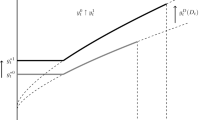Abstract.
Besley and Coate (1997 and 1998) exposit a formal model of dynamic fiscal policy that highlights the problem associated with the temporal mismatch between the incidence of benefits and costs. Their analysis focuses in part on the conditions that may result in inefficient public investment decisions in a representative democracy. This paper employs cross-national data to investigate implications of the Besley-Coate model. The findings indicate that several political institutions significantly affect public investments, including term lengths, staggered term expiration dates, and the separation of power between the executive and legislative branches. The findings also suggest that fiscal arrangements for redistributive payments may increase public investments.
Similar content being viewed by others
Author information
Authors and Affiliations
Additional information
Received: March 2000 / Accepted: May 2000
Rights and permissions
About this article
Cite this article
Crain, W. Sources of inefficiency in representative democracy: Evidence on public investments across nations. Econ Gov 3, 171–181 (2002). https://doi.org/10.1007/s101010100029
Issue Date:
DOI: https://doi.org/10.1007/s101010100029




